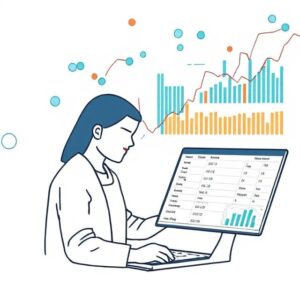Trends in Data Analytics
Data Analytics
Data analytics has become a crucial tool for businesses in today’s digital age. With technological advancements and the increasing value of data, organizations are constantly evolving their strategies to stay competitive. Here are the top trends in data analytics that are shaping how businesses use data for decision-making.
1. AI-Driven Analytics
Artificial intelligence (AI) is transforming how we analyze data. AI-powered tools can process large datasets much faster than traditional methods, uncovering insights and predicting trends with greater accuracy. Machine learning (ML), a subset of AI, helps improve these systems over time by learning from data, allowing businesses to make smarter decisions.
One of the most exciting developments is Natural Language Processing (NLP), which allows users to ask questions and receive data insights in simple, everyday language. This means non-experts can now analyze data without needing deep technical knowledge, making analytics accessible to everyone in an organization.
2. Augmented Analytics
Augmented analytics is an emerging trend where AI helps automate the analysis process. It reduces the manual effort involved in preparing, exploring, and visualizing data. By doing this, it enables data scientists and business users to focus on making decisions rather than spending time on complex data manipulation.
With the rise of AutoML (Automated Machine Learning), even non-technical users can now build predictive models, speeding up the process and reducing the demand for highly specialized skills.
3. Edge Analytics
Edge analytics refers to analyzing data at the source rather than sending it to a central location, such as the cloud. This is particularly important in industries like healthcare, manufacturing, and transportation, where real-time decisions are critical. By processing data on devices at the “edge,” companies can reduce latency and respond instantly to changes.
As IoT (Internet of Things) devices become more common, edge analytics is helping companies harness real-time insights and take immediate action without waiting for data to travel to a distant server.
4. Data Democratization
More businesses are adopting self-service analytics tools, which empower non-technical employees to access and analyze data on their own. These platforms simplify data exploration and visualization through user-friendly interfaces, allowing anyone within the organization to make data-driven decisions.
This trend is part of the larger movement towards data democratization, where data isn’t confined to technical teams but is available to everyone. It promotes collaboration, speeds up decision-making, and fosters a culture of data literacy.
5. Data Governance and Privacy
As companies collect more data, concerns around privacy and governance are becoming more significant. Regulations like GDPR (General Data Protection Regulation) and CCPA (California Consumer Privacy Act) require businesses to be transparent about how they collect and use data.
Data governance frameworks ensure that data is accurate, consistent, and secure. This is critical for organizations to maintain trust with customers and meet regulatory requirements. It also ensures that the data feeding into AI and analytics models is high quality and free of biases.
6. Cloud-Based Analytics
Cloud technology continues to play a key role in data analytics by offering businesses the flexibility to scale their operations. Cloud platforms like AWS, Microsoft Azure, and Google Cloud provide powerful tools for storing, analyzing, and visualizing large datasets without requiring heavy infrastructure investments.
With cloud analytics, companies can quickly process massive amounts of data, collaborate across teams, and integrate AI-powered tools, all from remote locations. This has been especially important with the rise of remote work.
7. Predictive and Prescriptive Analytics
Predictive analytics uses historical data to forecast future trends. It’s commonly used to predict customer behavior, market trends, or operational risks. As machine learning models get more sophisticated, these predictions become increasingly accurate.
Prescriptive analytics goes a step further by suggesting actions based on the predictions. For instance, it can recommend optimal pricing strategies or adjustments to inventory based on predicted demand, helping businesses make proactive decisions.
8. Data Storytelling and Visualization
Data isn’t useful unless it can be understood. That’s why data storytelling and visualization are becoming more important. Tools like Tableau, Power BI, and Google Data Studio allow users to create interactive dashboards that make complex data easier to interpret.
Good data storytelling combines clear visualizations with narrative context, helping decision-makers grasp insights quickly and take meaningful action. As data becomes more central to decision-making, the ability to tell stories with data is a critical skill.
9. DataOps
DataOps is a new practice that applies agile and DevOps principles to the field of data analytics. It focuses on streamlining the data pipeline—from data collection to analysis—to ensure faster, more accurate results.
This approach improves collaboration between IT, data engineers, and data scientists, helping organizations scale their analytics processes and reduce bottlenecks.
10. Ethics in Data Analytics
With the rise of AI and big data, ethical concerns are also growing. Ensuring that AI models are transparent, fair, and unbiased is crucial for building trust. Data ethics also involves maintaining privacy and avoiding misuse of personal information.
More companies are adopting ethical AI frameworks to ensure that their data practices are responsible, transparent, and aligned with regulations.
Conclusion
Data analytics is advancing rapidly, with trends like AI, edge computing, and augmented analytics leading the way. By embracing these innovations, businesses can unlock new insights, improve decision-making, and gain a competitive edge. However, it’s also important to focus on data governance, ethics, and security to ensure that data analytics is used responsibly. As the landscape continues to evolve, staying ahead of these trends will be key to thriving in the data-driven future.

We are also on Facebook
Go back to home page: www.mistyinfotech.com
If you want to Direct Data Entry Projects with Company with Us Please go here: Direct Data Entry Projects with Company







